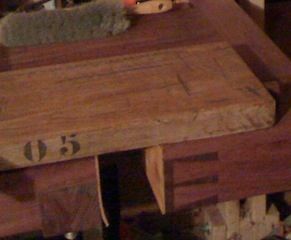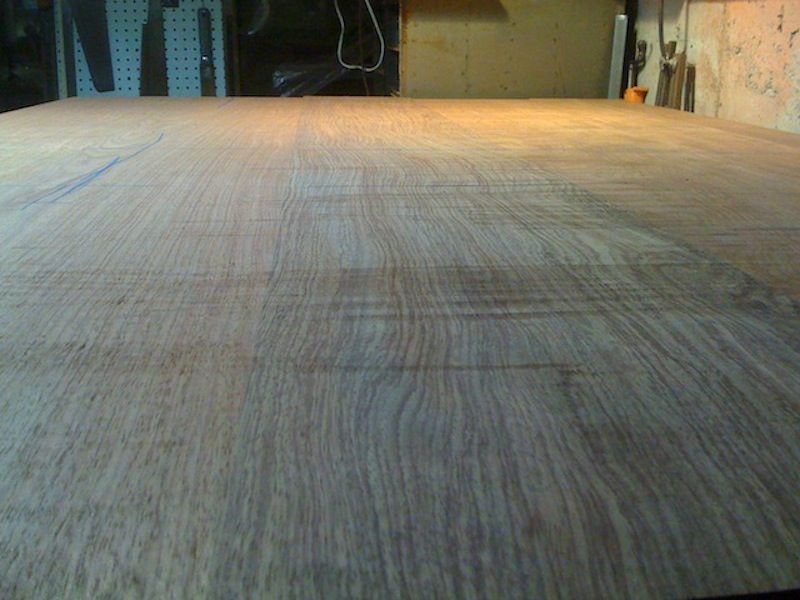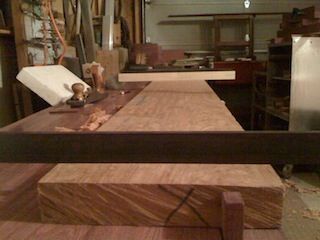As you know from earlier posts, I just flattened my bench. It was a learning experience, for sure. So I thought I'd jot down my thoughts and observations in an effort to help another newbie, some day. I know it won't help you "old hands", but every one of you helps me, every single time I ask. So this is kind of a "pay it forward" thing. I hope no one will mind, and I won't mind if anyone more experienced corrects my thinking. The idea is to help the next newbie.
1. I found it far harder than Rob Cosman (RC) or Christopher Schwartz (CS) made it look. (I spent most of a weekend doing this.) In hindsight, that shouldn't have been a surprise. Experienced guys always make things look easy, because they've been practicing for years. I'd surely fail miserably if I watched a Baryshnikov video and then tried to dance ballet. (Probably hurt myself too.) Why should using hand planes be any different?
2. Don't try to hog off material using your arms. I'd planed small pieces, but hadn't tried to flatten a long wide surface before this. My technique was horrendous and I was ready to give up hand tools after 4 hours of this punishment. Then, the guys told me "This is more like judo than weightlifting" - use your hips, legs and body - not your arms. Once warned, I think I finally got into a crude rhythm for doing that. Far more practice is required. This is probably not something one can learn (well) by reading it in a book. Better to find a good video or call someone at the local woodworking club to develop a more refined technique. (Judo - I liked that.)
3. If the edge on your bevel-up plane iron is chipping, try increasing the angle of the microbevel. I was using a LV BU Jointer for the basic flattening. (CS said to use a 7. RC said use an 8. Hence my choice.) My bevel was 25 degrees plus a 2 degree microbevel - 27 deg total. But the edge kept chipping and it was causing me to take more time re-sharpening than I wanted to - I had to keep going back to 600 grit, then 1200 grit, then finally honing on my 6000 grit Shapton. When I increased the microbevel from 2 degrees to 5 degrees (30 deg bevel, total), the chipping stopped. I wouldn't have believed that 3 degrees made such a difference until I tried this myself.
4. Don't get too hung up on tolerances. I started off trying to make the bench 0.004" flat over 38" (the length of my LV straight edge). I got nowhere near. But I did get down to 0.02" - 1/50th of an inch - using just my jointer plane. Being a hard-heard, I then set a goal to make it 0.01" - but no more than that. You can drive yourself nuts chasing close tolerances - especially in wood, a material that changes daily. So I switched to my Smoother and started working the highs and lows after making the "topo map" described later. As a valuable side lesson (for me, anyway), I got real insight into why it costs more money to work to closer tolerances - simply because it's a whole lot more work to hit 0.01" than it is to hit 0.02". You have to keep checking and tweaking and re-checking and re-tweaking. I knew that intellectually, but now I know it from experience. Experience is hard to beat.
5. To get it really flat, make a topographical map on your benchtop. Get out your straight edge and a pencil. Put the straight edge on the left end of your bench, parallel to the end (perpendicular to the length). Check for flatness with a feeler gauge. Mark the low spots and high spots. Then move the straightedge 1 or 2" to the right and repeat. When you get to the right edge, you're done. Now, turn your straight edge 90 degrees and place it along the back edge of your bench, parallel to the length of your bench. Repeat the feeler gauge work in this direction. Now you know where to take off material. (Thanks Chris Fournier!)
All-in-all, this was a painful but valuable experience. Now that it's done, I'm glad I attempted it. Now I just need to go work on my planing technique.
Thanks,
Fred




 Reply With Quote
Reply With Quote










